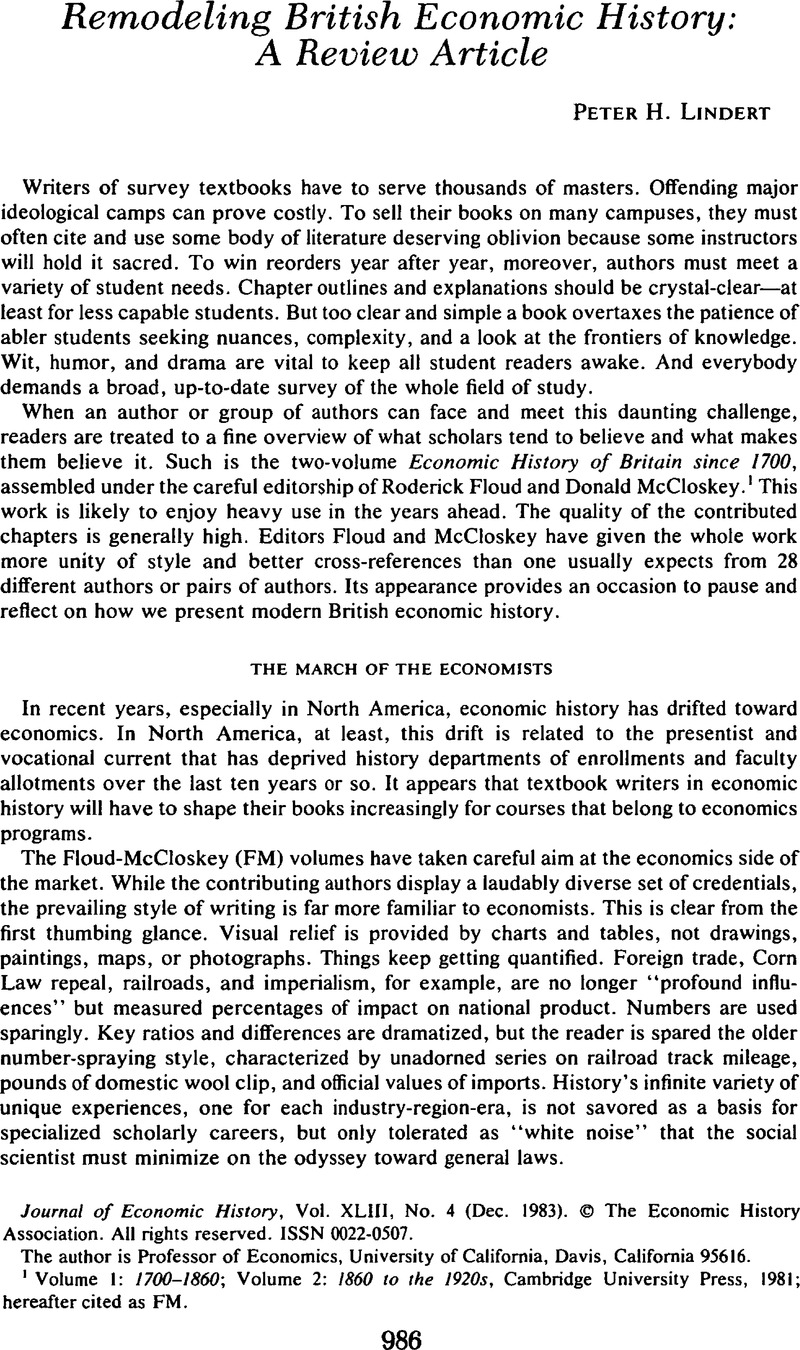Article contents
Remodeling British Economic History: A Review Article
Published online by Cambridge University Press: 03 March 2009
Abstract

- Type
- Review Articles
- Information
- Copyright
- Copyright © The Economic History Association 1983
References
1 Volume 1: 1700–1860; Volume 2: 1860 to the 1920s, Cambridge University Press, 1981; hereafter cited as FM.Google Scholar
2 Engels, F., The Condition of the Working Class in England, translated from the 1845 German edition, with an introduction by Hobsbawn, E. J. (St. Albans, 1974);Google ScholarAshton, T. S., “The Treatment of Capitalism by Historians”, in von Hayek, F. A., ed., Capitalism and the Historians (Chicago, 1954) andGoogle ScholarThompson, E. P., The Making of the English Working Class (Harmondsworth, 1968).Google ScholarAnyone seeking expanded empirical coverage of this basic issue of workers' well-being could start with Lindert, Peter H. and Williamson, Jeffrey G., “English Workers' Living Standards during the Industrial Revolution: A New Look”, Economic History Review, 2nd series, 36 (02 1983), 1–25, orGoogle ScholarMokyr, Joel, ed., Economics and the Industrial Revolution (forthcoming) and work back through sources cited there.Google Scholar
3 Extra readings here might include Chambers, J. D. and Mingay, Gordon, The Agricultural Revolution (London, 1966), ch. 4;Google ScholarBaack, B. D. and Thomas, R. P., “The Enclosure Movement and the Supply of Labor during the Industrial Revolution,” Journal of European Economic History (Fall 1974), 401–23;Google ScholarMcCloskey, Donald N., “The Economics of Enclosure: A Market Analysis,” andGoogle ScholarCohen, Jon S. and Weitzman, M. L., “Enclosures and Depopulation: A Marxian Analysis,” both in Jones, Eric and Parker, William, eds., European Peasants and their Markets (Princeton, 1975);Google ScholarDahlman, Carl, The Open Field System and Beyond (Cambridge, 1980), ch. 5; andCrossRefGoogle ScholarCrafts, N. F. R., “Enclosure and Labor Supply Revisited,” Explorations in Economic History (April 1978). Important but difficult reading is Robert C. Allen, “The Efficiency and Distributional Consequences of Eighteenth Century Enclosures,” Economic Journal (Dec. 1982).Google ScholarStudents can gain from reading C. Peter Timmer's seminal analysis of factor demand changes from the new husbandry (“The Turnip, the New Husbandry, and the English Agricultural Revolution,” Quarterly Journal of Economics, 83 (08 1969), 375–95) with an eye to pondering how such techniques might be applied to enclosures.CrossRefGoogle Scholar
4 For a provocative view of the rise of public education, use West, E. G., Education and the Industrial Revolution (London, 1975), chs. 7, 8, 15, 17 or his Education and the State, 2nd ed. (London, 1970), and the exchange betweenGoogle ScholarKiesling, H. J. and West in the Economic History Review (Aug. 1983). West's view, which emphasizes special-interest lobbying in the name of the public interest, can profitably be compared with more left views of the rise of public schooling, with the surprising result that the left and right (West) critiques agree to a large extent. This ideological interplay is more accessible if one is willing to combine British and American literature, e.g., usingGoogle ScholarBowles, Samuel and Gintis, Herbert, Schooling in Capitalist America (New York, 1976), chs. 8, 9 for counterpoint, andGoogle ScholarKaestle, Carl, “…Elite Attitudes toward Mass Education in Early Industrial England and America,” in Stone, Lawrence, ed., Schooling and Society (Baltimore, 1976) for a different interpretation. For a stimulating rgument that the 1833 Factory Act ended up being a device by owners of large steam-based textile mills to squeeze their smaller water-dependent rivals with hours restrictions,Google ScholarseeMarvel, Howard P., “Factory Regulation: A Reinterpretation of Early English Experience,” Journal of Law and Economics (Oct. 1977), 379–402.Google Scholar
5 Benjamin, Daniel K. and Kochin, Levis A. (BK), “Searching for an Explanation of Unemployment in Interwar Britain,” Journal of Political Economy, 87 (06 1979), 441–78, with a lengthy exchange between BK and their critics in the April 1982 issue of the same journal. This debate is a valuable complement to the more traditional treatments of the interwar macroeconomy in FM and inCrossRefGoogle ScholarWinch, Donald, Economics and Policy (New York, 1969), Part II.Google Scholar
6 The same suggestion of higher initial income levels and slower eighteenth-century growth emerges from Lindert, Peter H. and Williamson, Jeffrey G., “Revising England's Social Tables, 1688–1812,” Explorations in Economic History, 19 (10 1982), 385–408;CrossRefGoogle Scholaridem., “Reinterpreting Britain's Social Tables, 1688–1913,” Explorations in Economic History, 20 (Jan. 1983), 94–109, with an erratum in the July 1983 issue, pp. 329–30. Another revision should be noted here: The 1760 peak in the Deane and Cole and Cole-FM estimates seems to be a mirage. It stems entirely from the Keynesian assumption that the swollen military ranks of that year generated extra military product without taking any employment or output from the rest of the economy. With better data and better assumptions, we would probably find little deviation of the 1760 and 1770 figures from longer-run trends.Google Scholar
7 Mokyr, Joel, “Demand vs. Supply in the Industrial Revolution,” this JOURNAL, 37 (12 1977), 981–1008.Google Scholar
8 In Volume 2's treatment of the period 1860–1914, Barry Supple (ch. 6) also rejects demand-shift explanations, but for a different reason. He argues that no shifts occurred, whether or not they might have had a strong unit impact. The FM volumes do leave some room for demand-side forces, however. The introductory essays by Crafts (vol. 1, ch. 1), and Floud (vol. 2, ch. 1) avoid taking a stand. Ford (vol. 2, ch. 2) uses macro-demand arguments to explain deviations in national product around its moving-average trend. And T. Thomas (vol. 2, ch. 14) hauls out a heavy and fragile Keynesian econometric model to explore what alternative aggregate-demand policies might have done in the interwar period.Google Scholar
9 Lindert, Peter H. and Trace, Keith, “Yardsticks for Victorian Entrepreneurs,” in McCloskey, Donald N., ed., Essays on a Mature Economy (London, 1971), andGoogle ScholarAllen, Robert C., “International Competition in Iron and Steel, 1850–1913,” this JOURNAL, 39 (12 1979), 911–38.Google Scholar
- 4
- Cited by




